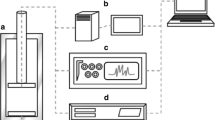In liquid water as a dielectric with a wide band gap, the Fermi level is a linear identifier of the redox potential of the aqueous medium, which serves as a measure of the loss of electrons on oxidation of water and their addition to it on reduction. A negative potential is required to suppress corrosion activity in the primary loop of VVER, which is achieved with a slight shift in the component composition of water H2O1–z to the hypostoichiometric zone 0 < z < 25·10–13 with the formation of hydroxonium radicals H3O as the strongest reducing agents. However, on low-temperature monitoring of such a potential in the VVER primary loop, significant distortions of its readings are possible.
Similar content being viewed by others
References
V. Garbuio, M. Cascella, and O. Pulci, “Excited state properties of liquid water,” J. Phys.: Condens. Matter, 21, No. 3, 1–15 (2009).
P. Couto, R. Guedes, and B. Costa-Cabral, “The density of states and band gap of liquid water by sequential Monte Carlo and quantum mechanics calculations,” Brazil. J. Phys., 34, No. 1, 42–47 (2004).
P. Couto, Understanding Electronic Properties of Water: a Theoretical Approach to the Calculation of the Adiabatic Band Gap of Liquid Water: Thesis for PhD Degree, Lisbon University (2007).
A. Shimkevich, “Electrochemical view of the band gap of liquid water for any solution,” World J. Condens. Matter Phys., 4, 243–249 (2014).
A. L. Shimkevich, The Basics of Electrochemical Modifying of Liquid Dielectrics, LAMBERT Academic Publ., Dusseldorf (2017).
A. Bard, R. Parsons, and J. Jordan,Standard Potentials in Aqueous Solutions, Marcel Dekker, NY (1985).
Ch. Kittel and H. Kroemer, Thermal Physics, W. Freeman, San Francisco (1980).
A. L. Shimkevich and I. Yu. Shimkevich, “On 2D water chemistry,” in: Proc. Int. Conf. Nuclear Plant Chemistry (Paris) (2012), P1-39-176.
A. V. Bandura and S. N. Lvov, “The ionization constant of water over wide ranges of temperature and density,” J. Phys. Chem. Ref. Data, 35, 15–30 (2006).
Author information
Authors and Affiliations
Corresponding author
Additional information
Translated from Atomnaya Énergiya, Vol. 132, No. 4, pp. 191–195, April, 2022.
Rights and permissions
Springer Nature or its licensor (e.g. a society or other partner) holds exclusive rights to this article under a publishing agreement with the author(s) or other rightsholder(s); author self-archiving of the accepted manuscript version of this article is solely governed by the terms of such publishing agreement and applicable law.
About this article
Cite this article
Shimkevich, A.L. Possible Distortions of Low-Temperature Monitoring of the Water Redox Potential in VVER Primary Loop. At Energy 132, 197–201 (2022). https://doi.org/10.1007/s10512-023-00927-2
Received:
Published:
Issue Date:
DOI: https://doi.org/10.1007/s10512-023-00927-2




